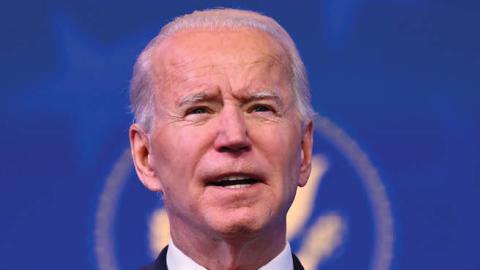Eleven million persecuted Uighurs and other Muslims in China’s Xinjiang autonomous region got a first taste of justice on January 19 when then Secretary of State Mike Pompeo declared that the Chinese government is committing genocide against them. History has shown that condemning genocide is an essential initial step to stopping it and preventing it from happening again.
Although some media figures downplayed the Uighur genocide determination as merely Pompeo's “parting shot” at China, this is the single most important U.S. human rights measure of the past four years. It came after a monthslong deliberative process by the State Department’s Office of Global Criminal Justice. The determination was based in critical part on new information showing that forced birth prevention measures inside Xinjiang reeducation camps are aimed at suppressing Uighur demographics and are part of a destructive state campaign against minorities in the region.
Both President Biden and Secretary of State Blinken expressed agreement with the genocide determination. But whether they will keep pressure on an angered China remains to be seen. The Uighur genocide is an inconvenient fact for the administration’s foreign policy climate change priorities. Barely a week after Pompeo's statement, U.N. Secretary General Guterres pleaded in the interest of “climate action” partnership for a U.S.-China “reset” to put aside “different views” on human rights—including, presumably, the U.S. genocide determination. By his sights, the U.S. will have to make hard choices about its China policies.
After the Holocaust, genocide was criminalized under the international Genocide Convention of 1948, and became the most heinous human rights crime in American popular conception. A genocide branding affects foreign affairs, which helps explain why only twice before has the United States applied it to ongoing atrocities. Pompeo was able to move forward on the Uighur genocide declaration by making it a “policy” determination. In 2016 the genocide of Middle Eastern Yazidis and Christians was a “personal designation” of then Secretary of State Kerry. The 2004 Darfur genocide determination was a “legal” one, backed by department lawyers. But no matter what the determination is called, genocide requires a U.S. policy response.
Last May, then Ambassador-at-Large for Global Criminal Justice Morse Tan took up the Uighur’s plight, to assess whether it fit the Convention’s genocide definition of an ethno-religious community targeted for destruction “in whole or in part.” The State Department’s religious freedom reporting since 2017 documented the destruction of two-thirds of the Uighur mosques, the detention for alleged Islamic extremism of over a million Uighurs in reeducation camps, and other egregious acts of repression. The former ambassador told me in a phone interview that he had amassed additional evidence from open sources, which department lawyers promptly classified for 25 years. He directed me to Pompeo’s statements for further insights.
In a January 19 Wall Street Journal op-ed, Pompeo emphasized “key” evidence of plunging Uighur birthrates. Noting that the Genocide Convention encompasses “measures intended to prevent births within the group,” he cited “the Communist Party’s efforts to stop Uighur women from giving birth via forced abortion and sterilization,” and “involuntary contraception measures, such as forced insertions of intrauterine devices.” Specifics can be found in a 2020 report by Jamestown Foundation expert Adrian Zenz, which revealed Chinese government documents verified by the AP. They showed that Xinjiang birthrates dropped some 24 percent from 2018 to 2019, compared with a 4.2 percent decline in China overall. They also indicated that violation of government birth limits—set below replacement level for the minority—is the most common reason Uighur women are detained.
This official data supports anecdotal accounts from Uighur refugees. For example, former detainee Gulbahar Haitiwaji wrote of being forcibly sterilized by injection. “That was when I understood the method of the camps, the strategy being implemented: not to kill us in cold blood, but to make us slowly disappear. So slowly that no one would notice,” she recounted. In 2018, Rep. Chris Smith chaired congressional hearings where former detainee Mihrigul Tursun testified about being restrained and tortured with electrical currents and mocked for her belief in God. Others described the brutality behind China’s forced abortions.
Pompeo also cited “arbitrary and indefinite detentions” in camps, where Uighurs were tortured, raped, and forced to do hard labor. In these camps, deaths occurred in unexplained circumstances. He noted Xinjiang’s draconian high-tech surveillance. Last week, the BBC reported on rape by electric prods and police gang rapes in the camps. These are all red flags, with the evidence of birth prevention constituting the smoking gun.
Beijing remains defiant about its repressive governance. Last September, President Xi declared that the Xinjiang strategy is “totally correct and must carry on for a long time.” As for the horror about Uighur women detainees, China’s Washington embassy tweeted a jaw-dropping boast on January 7 (deleted by Twitter on January 8) that seemed consciously patterned on the Nazis’ “work sets you free” messaging at Auschwitz:
The minds of Uygur women in Xinjiang were emancipated and gender equality and reproductive health were promoted, making them no longer baby-making machines. They are more confident and independent.
Were the U.S. State Department to quietly drop its concern about the Uighur genocide for the sake of climate change partnership with China, it would be tragic for the Uighur Muslims. It would also thoroughly betray the 73-year genocide pledge of “never again” and Americans’ human rights values. This will be a defining issue for the Biden administration.
Read in First Things















